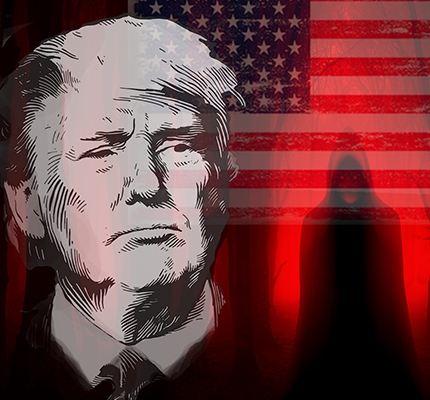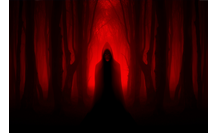
The Trump administration’s response to COVID-19 can be characterized as disjointed, to put it mildly, or as chaotic, to be less charitable. President Trump has routinely contradicted the advice from the officials of the Centers for Disease Control, explained away the high number of cases as only the result of widespread testing efforts, and claimed the disease was declining and even that it would disappear in a matter of weeks. The President has occasionally recommended that Americans wear masks to reduce the spread of the disease while not wearing a mask himself. Perhaps most surprisingly, as the American COVID-19 crisis was ramping up in mid-March, the President deflected criticisms of his administration's lack of preparation by stating, "I don't take responsibility at all." The American presidency has long been framed in relation to Harry S. Truman's famous desk sign "The Buck Stops Here," making Trump's disavowal of responsibility all the more surprising.
Trump's disjointed rhetorical response has, of course, not been entirely successful. Several Pew Charitable Trust polls have suggested that public opinion about the disease, its severity, and its handling is largely divided along partisan lines. But, as Jennifer Mercieca notes in her insightful book, Demagogue for President, what might seem disjointed and chaotic has routinely played to Trump's advantage. So, while the empirical facts about the pandemic might suggest the administration's response has been a failure, there are still audiences who find the President's framing of the disease and his responses to it reasonable and compelling.
Other rhetorical scholars also have spent considerable time exploring the rhetorical dynamics of the Trump presidency. Ryan Skinnell's edited volume, Faking the News, collects rhetorical examinations of Trump's persuasive techniques. Roderick Hart also engages this topic in his book, Trump and Us. These and other scholars have consistently suggested that Trump's rhetoric emphasizes divisiveness and a consistent "us" versus "them" theme, and his response to COVID-19 has largely followed suit. The President has, for example, consistently labeled the virus the "Wuhan" or "China virus" in an effort to stoke nationalist, xenophobic, and racist prejudices against China and Chinese people. Indeed, Trump has framed the nation's response to COVID-19 as a war against an enemy. Interestingly, one consistent strand of his often-inconsistent rhetoric around the disease has been his labeling it an "invisible enemy." In a tweet on March 18, 2020, President Trump declared "we are at war with an invisible enemy" and the phrase remains a relatively consistent part of his and his administration's vocabulary. He used the phrase during his 2020 RNC acceptance speech when he proclaimed, "our nation and the entire planet has been struck by a new and powerful invisible enemy."
[W]hile the "invisible enemy" can suggest the virus itself, it also can suggest dangerous foreign enemies, the news media, and even the state itself. A phrase such as "invisible enemy" is rhetorically powerful not only because of its versatility in designating various entities, but also because of its emotional power.
At one level, characterizing COVID-19 as an invisible enemy makes sense; the disease is microscopic and spreads from person to person via unseen globules. The notion of an invisible enemy also aligns with other periods of American crisis. During the Cold War, for example, propaganda often depicted Communism and Communist infiltrators as an unseen threat lurking in the shadows. Indeed, the phrase "invisible enemy" is useful in that it can be understood in different ways by different audiences, following the "rhetorical versatility” concept James Chase Sanchez offered in an essay in the Journal of Contemporary Rhetoric." So, while the "invisible enemy" can suggest the virus itself, it also can suggest dangerous foreign enemies, the news media, and even the state itself.
A phrase such as "invisible enemy" is rhetorically powerful not only because of its versatility in designating various entities, but also because of its emotional power. There is a certain menacing dread in facing an enemy who is both threatening and unseen. Perhaps the best way to think about the emotional potency of an invisible enemy is to understand it as a monster. Indeed, in an April 8, 2020 tweet, President Trump imagines the days when we can move past what he calls "the horror of the invisible enemy." Understanding the way President Trump has constructed COVID-19 as a monster, then, requires us to think about monstrosity in our culture, especially in our popular culture. In a way, this representation makes perfect sense, as Trump is arguably the first "pop culture president," having gained fame largely through his appearances in tabloids, films, and reality television. So, consider how we think about monsters and how we construct monstrosity in American culture.
The Rhetoric of America's Horror Story
 Scholars who are interested in horror narratives have long understood the genre as deeply implicated in its contemporary political culture. Robin Wood, for example, understood horror narratives as an indication of what a particular culture represses and thought of the monster as a kind of representation of those repressed issues. Other scholars, including Linnie Blake, Adam Lowenstein, and Claire Sisco King have explored horror films as they relate to issues of cultural trauma. Horror films are often viewed as a kind of cultural barometer and means of exploring broader cultural fears and anxieties. In my own work in this area, I've found it useful to think of the relationship between fictional narratives of fear and the real fears and anxieties with which they connect, not in terms of allegory but more in terms of resonance. In my book, Projected Fears, I argue that "an influential horror film does not necessarily create a certain pattern of fear or anxiety within a culture; instead, elements within the film resonate – connect in some sympathetic manner – to trends within the broader culture." This sense of resonance, thus, entails not only allegorical and representational elements, but also affective elements. A monster, in other words, doesn't just look scary; it needs to feel real, no matter how unreal it might actually be.
Scholars who are interested in horror narratives have long understood the genre as deeply implicated in its contemporary political culture. Robin Wood, for example, understood horror narratives as an indication of what a particular culture represses and thought of the monster as a kind of representation of those repressed issues. Other scholars, including Linnie Blake, Adam Lowenstein, and Claire Sisco King have explored horror films as they relate to issues of cultural trauma. Horror films are often viewed as a kind of cultural barometer and means of exploring broader cultural fears and anxieties. In my own work in this area, I've found it useful to think of the relationship between fictional narratives of fear and the real fears and anxieties with which they connect, not in terms of allegory but more in terms of resonance. In my book, Projected Fears, I argue that "an influential horror film does not necessarily create a certain pattern of fear or anxiety within a culture; instead, elements within the film resonate – connect in some sympathetic manner – to trends within the broader culture." This sense of resonance, thus, entails not only allegorical and representational elements, but also affective elements. A monster, in other words, doesn't just look scary; it needs to feel real, no matter how unreal it might actually be.
The monster lies at the heart of our resonant connection to narratives of horror. As Edward J. Ingebretsen notes in an essay in Religion and American Culture, a monster is constructed at the "symbolic center of social energy." Of course, not every threatening entity or enemy is a monster. If the administration had simply presented the virus as a threat to public health, then its rhetoric might not have tapped into the social energy surrounding a monster. In his Philosophy of Horror, Noël Carroll notes that in addition to being threatening, a monster must violate our assumptions about the world. In this instance an invisible, as opposed to microscopic, enemy is unnatural. The invisible enemy is unknown and can threaten us anywhere and in diverse ways. Thus, it is monstrous.
Beyond being unnaturally threatening, monsters are also created. They are pieced together out of various aspects of our culture. Reviewing Bernadette Marie Calafell's “Monstrosity, Performance, and Race in Contemporary Culture” in Text and Performance Quarterly, Lore/tta LeMaster notes that "the technology of monstrosity is a dynamic tapestry reflecting a multitude of intersectional cultural producers' and consumers' desires and fears." Scholars such as Calafell and LeMaster remind us that the construction of monsters occurs, at least symbolically, in the real world, as our culture labels and depicts certain individuals and populations as monstrous. In an insightful essay in Communication and Critical/Cultural Studies, Eric King Watts examines the way popular zombie narratives have structured our cultural imaginary surrounding race. Something similar might be occurring with the rhetorical construction of COVID-19 as an invisible and shape-shifting monster that might be lurking anywhere.
The Horror of the Invisible Enemy
 Inflecting a global pandemic through the language of horror and monstrosity certainly makes sense at the present moment. Horror seems to have entered into a third Golden Age with the popularity of such horror films as Get Out (2017), A Quiet Place (2018), and Midsommar (2019), and television shows including The Walking Dead, The Haunting of Hill House, and American Horror Story. Contemporartexty popular culture, it would seem, is full of monsters. In the introduction to their Monster Culture in the 21st Century, Marina Levina and Deim-my T. Bui contend that monster narratives "have become omnipresent specifically because they represent collective and social anxieties over resisting and embracing change in the twenty-first century." As COVID-19 is one of the most profound moments of global challenge and change in this new century, it is not surprising that it is depicted in monstrous terms.
Inflecting a global pandemic through the language of horror and monstrosity certainly makes sense at the present moment. Horror seems to have entered into a third Golden Age with the popularity of such horror films as Get Out (2017), A Quiet Place (2018), and Midsommar (2019), and television shows including The Walking Dead, The Haunting of Hill House, and American Horror Story. Contemporartexty popular culture, it would seem, is full of monsters. In the introduction to their Monster Culture in the 21st Century, Marina Levina and Deim-my T. Bui contend that monster narratives "have become omnipresent specifically because they represent collective and social anxieties over resisting and embracing change in the twenty-first century." As COVID-19 is one of the most profound moments of global challenge and change in this new century, it is not surprising that it is depicted in monstrous terms.
Trump consistently portrays the "invisible enemy" as a threat. While this rhetoric belies Trump’s routine dismissals of the pandemic and speculations that it will simply disappear at some point, when he talks about the "invisible enemy," he always frames it as a significant and pernicious threat. On April 5th, for example, Trump tweeted: "We are learning much about the Invisible Enemy. It is tough and smart, but we are tougher and smarter." Here the President attributes not only threat but also agency and cunning to the virus, though he reassures his readers that "we" are capable of defeating it. The invisible enemy is not only depicted as an intelligent actor but also as, at least implicitly, an unholy threat. In his remarks at the Easter Blessing on April 10, 2020, Trump observed: "As our nation battles the invisible enemy, we reaffirm that Americans believe in the power of prayer" and that "we place our trust in the hands of Almighty God."
The invisible enemy is everywhere, and its ubiquity serves as an existential threat that reminds every American of their precarity in the face of it.
Defeating this unholy threat will not be easy. Note the ways in which the monstrous invisibility of the enemy was employed when Trump discussed the uselessness of lockdowns as a public health measure during an April 3 press briefing: "This is a very tough, invisible enemy – lockdowns do not prevent infection in the future. They just don't. It comes back. Many times, it comes back." Much like a horror film monster, the virus just keeps coming back with its ubiquitous and unholy threat to Americans. In this construction, the virus resembles the monster from the 2014 film It Follows, which Casey Kelly describes in an essay in Critical Studies in Media Communication, as "an anonymous and relentless force." The invisible enemy is everywhere, and its ubiquity serves as an existential threat that reminds every American of their precarity in the face of it. Interestingly, this is a precarity that the President suggests only he can resolve.
The ubiquitous and amorphous nature of the invisible enemy allows the President to project onto it various identities and forms. As Trump remarked during a visit to a Whirlpool plant in Ohio on April 7th: "We call it the 'China Virus.' We call it the 'invisible enemy.' We call it many different names. It's got many different names, but it's bad." The interchangeability of these names makes sense for an invisible invader, and the President seeks to equate the virus’s monstrosity with foreignness through the juxtaposition of his other favored name for COVID-19, the "China virus."
This depiction of foreignness and foreigners as monstrous is, of course, nothing new. In my recent book A Place of Darkness, I explored how American horror films emerged in conjunction with depictions of non-Americans as superstitious and dangerous. This lingering logic continues in the President's rhetorical construction of the invisible enemy and is not limited to attacks on China. On April 20th, the President tweeted: "In light of the attack from the Invisible Enemy . . . I will be signing an Executive Order to temporarily suspend immigration into the United States." Popular culture has long constructed the monster out of racial and xenophobic anxieties. The invisible enemy seems to be stitched together out of similar parts.
But the invisible enemy is not confined to the foreign. In an April 27th tweet, Trump lamented: "There has never been, in the history of our Country, a more vicious or hostile Lamestream Media than there is now, even in the midst of a National Emergency, the Invisible Enemy!" The construction of the tweet leaves open to interpretation whether the final clause refers to the emergency or the media, but based on the President's consistent railing against the news media, I would suggest that they may also be a form of this monstrous invisible enemy.
This sense that the invisible enemy is already here, lurking nearby, not only fits with contemporary horror narratives but also with Trump's broader rhetoric about deep state conspiracies and their threat to him and his vision for the country. A quick search of social media finds the phrase "invisible enemy" regularly being employed by those who believe in the sprawling QAnon conspiracies, which find the enemy lurking in our corporations, governments, and media. In an August 22, 2020, tweet, the President impugned the actions of his own administration's Food and Drug Administration, worrying that "The deep state, or whoever, over at the FDA is making it very difficult for drug companies to get people in order to test the vaccines and therapeutics." Evidently, the invisible enemy can lurk even among those charged with fighting it.
Perhaps the contemporary horror film that best captures the rhetoric of the invisible enemy as employed by Trump and his administration is Leigh Whannell's 2020 aptly titled The Invisible Man. In this loose adaptation of the H.G. Wells novel, the protagonist is a woman, Cee, who escapes an abusive husband only to be told he has died. Yet, in spite of his apparent death, she becomes convinced that he is tormenting her. As with Trump's construction of COVID-19, the invisible enemy is always where we least expect it and is often hiding in the spaces where we feel most safe.
The film also offers insight into the dangers of the rhetoric of an invisible enemy. The Invisible Man is an interesting depiction of gaslighting, as all those around the protagonist are convinced Cee is deluded. Nevertheless, one by one, they all fall victim to her murderous invisible husband. In the end, the real threat to those in the film lies in not listening to Cee and instead being misdirected to look for the monster in all the wrong places. The lesson seems clear. When fighting invisible enemies, don't become distracted. Don't let others mislead you with false alarms. Don't fall into suspicion and paranoia. Stay focused on the real monster.
ABOUT THE AUTHOR

KENDALL R. PHILLIPS is Professor of Communication & Rhetorical Studies at Syracuse University and Founding Co-director of the Lender Center for Social Justice. He is author of several books, including: A Place of Darkness: The Rhetoric of Horror in Early American Cinema; Dark Directions: Romero, Craven, Carpenter and the Modern Horror Film; and Projected Fears: Horror Films and American Culture. He is co-editor, along with Charles E. Morris III, of The Conceit of Context: Resituating Domains in Rhetorical Studies, forthcoming from Peter Lang.

